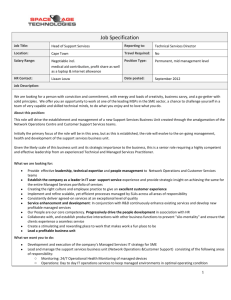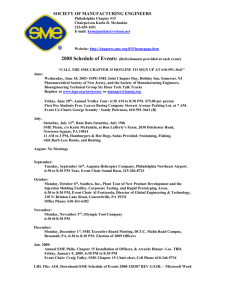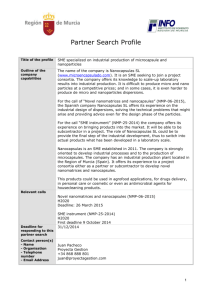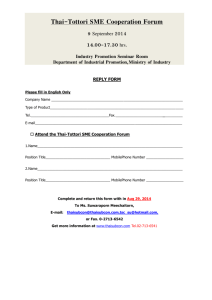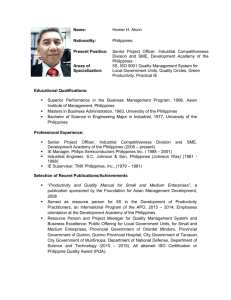Tool - Meso-NRW
advertisement
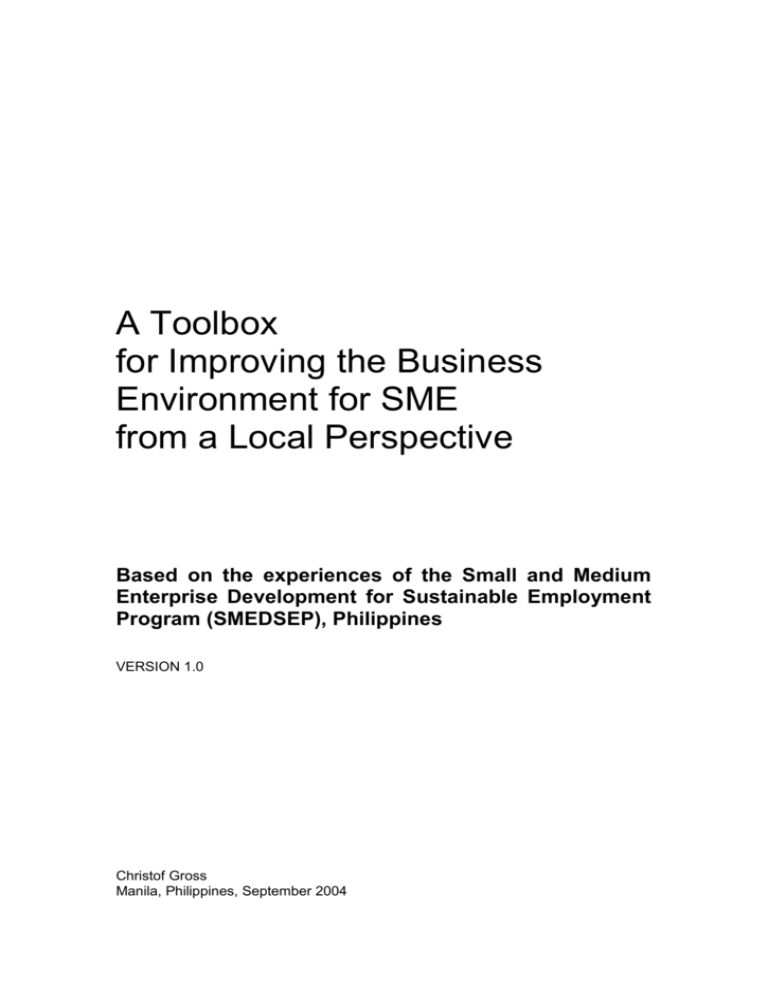
A Toolbox for Improving the Business Environment for SME from a Local Perspective Based on the experiences of the Small and Medium Enterprise Development for Sustainable Employment Program (SMEDSEP), Philippines VERSION 1.0 Christof Gross Manila, Philippines, September 2004 1. Objective and target group of this paper This paper marks the launching of a toolbox on the improvement of the political, legal and regulatory business environment for small and medium businesses. The findings presented here are based on the experiences of the Philippine-German development cooperation project called “Small and Medium Development for Sustainable Employment Program (SMEDSEP)”. An attempt is made to synthesize the approach taken into somewhat standardized and hopefully replicable tools in order to feed the knowledge generated by SMEDSEP into the knowledge management system of GTZ, to inform the work on similar approaches and to serve as an input to the wider donor community in its quest for improving the business environment for small enterprises. Therefore, the main target audience consists of practitioners working with donor agencies, be it in the field, concerned with actual implementation questions or in headquarters, where the focus is on planning, monitoring and concept development. From our judgment, the relevance of this toolbox extends beyond a narrow SME perspective to include such topics as local and regional development, decentralization, good (regulatory) governance and administrative reform. Last but not least, we envision that members of international bodies such as the Committee of Donor Agencies for Small Enterprise Development might find the present work interesting in distilling what works and what does not. Finally, it should be stressed that this toolbox is intended to be a living document, in which further tools and experiences with them will be added as the program’s implementation unfolds. Admittedly, this is making a virtue of necessity as the program is still in its beginnings. Therefore, the foundation of this toolbox is laid by the analysis stage and the six main tools identified there. Despite this limitation, we still deem it useful to present these tools and their application according to our “guiding principles” to serve the above-mentioned users and functions. - at a glance The Small and Medium Enterprise Development for Sustainable Employment Program (SMEDSEP) The Philippine government increasingly regards SMEs as the driving force behind economic and social development. However, structural and institutional problems are hampering efficient and dynamic management at both national and regional level. The Micro, Small and Medium-size Enterprises (MSMEs), are struggling with a multitude of economic-policy, legal and bureaucratic obstacles. Among these are cumbersome license and regulatory procedures as well as insufficient access to markets, business services, training and upgrading and financial and credit services. The investment climate of the Philippines thus is not conducive to the full usage of entrepreneurial capacities of MSMEs. SMEDSEP goal The overall goal of the program is thus that state and private institutions shape the investment climate in the Philippines, and particularly in the Visayas, in a way that enables the development and use of entrepreneurial potential and stimulates competition. SMEDSEP target group SMEs and micro-enterprises with growth potential SMEDSEP components 1. Enhancement of SME policies, laws, and regulations, 2. Market development for services relevant to MSMEs, 3. Improvement of access to middle and long-term financial credit, and 4. Market development for Demand-Driven Technical Vocational Education and Training programs Partners Government - Department of Trade and Industry (DTI) - Technical Education and Skills Development Authority (TESDA) - Local Government Units (LGUs) Private Sector - Local Business Development Service (BDS) Providers - Private Banks - Associations and Chambers - Human Resource Development (HRD) Providers - For further information, please visit our website at www.smedsep.ph - 2 2. Introduction According to the Committee of Donor Agencies for Small Enterprise Development’s working group on enabling environment1, the business environment contains a broad range of elements among which the following are deemed most relevant for donor interventions: • • • • Macroeconomic strategies – particularly those that influence the performance of small enterprises Governance issues – as they relate to the governance, enforcement and promotion of the small enterprise sector Policy, legal and regulatory framework for small enterprise activity Organizational framework for the promotion, representation, monitoring and review of small enterprises While there are certainly other elements of the business environment that can and do affect the performance of small enterprises (e.g., infrastructure, access to financial services, quality of the labor force), the present paper focuses on policies, laws and regulations for two reasons. First, improving the legal and regulatory framework for the operation of small businesses is a rather recent innovation in donor interventions. Therefore we felt it was worthwhile to describe the SMEDSEP approach, its tools and the experiences made and lessons learned so far. This is to inform and support others faced with similar tasks and to provide an input to the donor discussion on the design and implementation of such interventions. Secondly, in light of the limited experiences made so far in this field, we assume there is a demand for concrete tools to provide some guiding in the process. Admittedly, the program has itself just started but the experiences made so far in the analysis stage seem already worth sharing. As a living document, this paper will evolve along with the program’s implementation and more tools will be added as further implementation stages unfold. The political, legal and regulatory situation for SME in the Philippines – in brief SME and their specific concerns have recently gained some prominence in the Philippines through policies such as the Magna Carta for Small Enterprises of 1997 (definition of SME and establishment of various government support services), the Barangay Micro Business Act of 2002 (encouraging micro enterprises to formally register by e.g. exempting them from taxes and minimum wage laws) and the SME Development Plan 2004 –2010 (calling for broad based support to foster competitiveness and growth of SME). Last but not least, the newly elected president Gloria Macapagal Arroyo announced that her administration would seek to create one million new jobs a year by supporting entrepreneurs. These initiatives aim at improving SME performance at various levels and thus constitute the favorable political framework in which SMEDSEP works to improve the business environment for SME. Nevertheless, SME are still faced with a number of tedious and cumbersome legal and regulatory procedures, which act as a drain on managerial time and productive usage of resources. Even worse, such an environment may work as a severe See Committee of Donor Agencies for Small Enterprise Development (DRAFT, April 2004): “Promoting practical frameworks for donor agencies in the reform of the business environment for small enterprise development – Proposals for the Committee of Donor Agencies for Small Enterprise Development presented by the Working Group on Enabling Environment” 1 3 disincentive to register one’s business, which keeps entrepreneurs from availing of various (government, financial) services and seriously biases official statistics and planning. An indication of the magnitude of this concern is given in table one below, which shows the strikingly large proportion of the informal economy in the Philippines, second only to Thailand in the region. Table 1: Economy Characteristics Informal Economy (% GNI) Year GNI per Capita (US$) AVERAGE 2003 5,303 24.29 Cambodia 2003 300 .. China 2003 960 13.1 1,271,849,984 Hong Kong, China Indonesia 2003 24690 16.6 6,725,000 2003 710 19.4 208,981,088 Lao PDR 2003 310 .. Malaysia 2003 3540 31.1 23,802,360 Mongolia 2003 430 18.4 2,421,360 Papua New Guinea Philippines 2003 530 .. 5,252,530 2003 1030 43.4 Singapore 2003 20690 13.1 4,131,000 Taiwan, China 2003 13320 19.6 22,342,000 Thailand 2003 2000 52.6 61,183,900 Vietnam 2003 430 15.6 79,526,048 Country Population 137,092,360 12,265,220 5,403,170 78,317,032 Source: http://rru.worldbank.org/DoingBusiness/ In order to provide an example of the ineffective governance of the business sector, the procedure to start a business may serve as an illustration2. Table two below shows the number of procedures, the total duration, the cost and minimum capital requirement it takes to start a business in the Philippines and places this in the regional comparative perspective. Table 2: Starting a Business Country Year # of Procedures Duration (days) Cost (% GNI per capita) Min. capital (% of GNI per capita) AVERAGE 2003 8 66 56.8 646.8 Cambodia 2003 11 94 553.8 1,825.80 China 2003 11 46 14.3 3,855.90 Hong Kong, China Indonesia 2003 5 11 2.4 0 2003 11 168 14.5 302.5 Lao PDR 2003 9 198 19.5 150.7 Malaysia 2003 8 31 27.1 0 Mongolia 2003 8 31 12 2,046.90 Papua New Guinea Philippines 2003 7 69 26.4 0 2003 11 59 24.4 9.5 Singapore 2003 7 8 1.2 0 Taiwan, China 2003 8 48 6.1 217.4 Thailand 2003 9 42 7.3 0 Vietnam 2003 11 63 29.9 0 Source: http://rru.worldbank.org/DoingBusiness/ 2 The survey examined commercial or industrial firms with up to 50 employees and start-up capital of 10 times the economy's per-capita GNI (Gross National Income). It counted all procedures (defined as a legal requirement that involves a separate interaction between the firm and an outside entity -- officials, notaries, etc) required to register a firm. Data also include screening procedures by a set of overseeing government entities, tax- and labor-related registration procedures, health and safety procedures, and environment-related procedures. For more details on the methodology please refer to http://rru.worldbank.org/DoingBusiness/Methodology/StartingBusiness.aspx 4 Although the Philippines is not substantially worse than other economies in the region when it comes to starting a business, the shining examples of Hong Kong and Singapore demonstrate that there is much room for improvement. While table two above presents the ‘official’ process, in that it takes into account the procedures, duration and cost as mandated by the respective laws and regulations, the relevance of this assessment can be greatly increased by also including the business perspective on government effectiveness. Table three below is based on data generated by the World Bank’s Investment Climate Survey Online 3 and gives some information on where the business sector sees major problems when interacting with the public sector. anti-competitive/ informal practices 24.71% 13.52% 29.50% 35.17% 24.27% Officials' interpretation of laws consistent & predictable corruption 21.66% Efficiency of government in delivering services econnomic & regulatory policy uncertainty Fully disagree OR disagree in most cases licensing and operating permits Inefficient OR very inefficient labor regulations Major obstacle OR 25.14% Very severe obstacle customs and trade regulations tax administration Table 3: Government as a business obstacle 33.97% 24.93% Source: Worldbank, Investment Climate Survey Online, Philippines 2003 It is worrying to see that on average about a fourth of all enterprises rank these governance issues as major problems. According to this survey, corruption and inefficient delivery of government services are the most pronounced government failures in the business sector’s dealings with the authorities. This very much points to the fact that it is not just the procedures, which an enterprise has to go through as stipulated by laws and regulations but also (and maybe even more so) the way these transactions are administered and carried out. In conclusion, the brief discussion above provides three rationales for tackling policies, laws and regulations in order to improve the business environment for micro, small and medium enterprises in the Philippines: (1) the share of the informal economy in the Philippines is the second largest in the region, which may at least in part be due to the business unfriendly regulatory environment, (2) there is a wide discrepancy between actual and available best practice government-private sector interaction, (3) the implementation of laws and regulation is plagued with inefficiencies, corruption and unnecessary costs to businesses. SMEDSEP has taken on this task. In what follows, the program’s guiding principles that shape its approach as well as the tools proper will be presented. 3 Investment Climate Assessments (ICAs) look in detail at factors constraining the effective functioning of product markets, financial and non-financial factor markets, and infrastructure services, including, in particular, weaknesses in an economy’s legal, regulatory and institutional framework. ICAs also provide the tools and analytical framework to identify reform priorities in a country’s investment climate, by linking constraints to firm-level costs and productivity. Underpinning all ICAs is a standard core Productivity and Investment Climate Survey (PICS) instrument, which allows the identification of existing conditions, the benchmarking of conditions to monitor changes over time, and the analysis of the impact of these conditions on firm-level performance. ICAs further employ a common structure and methodology to facilitate comparability between countries. 5 3. The SMEDSEP approach towards improving policies, laws and regulations This paper introduces the tools that are used in SMEDSEP’s approach to improve policies, laws and regulations. In doing so, it answers the question “What has been done?”. Equally important, however, seems to be the question “How has it been done?” because being knowledgeable about a tool is a necessary but not sufficient precondition for successful implementation. Therefore, we have tried to distill the following ‘guiding principles’ for SMEDSEP’s interventions: - - - - - - Usage of a comprehensive approach towards improving the business environment. While the central unit for the improvement of the business environment is the city, laws and regulations on the national level will be studied simultaneously in order to safeguard coherence. Focus on the local level. The responsiveness of local authorities to business needs and the rules and regulations set locally as well as the way they are implemented contribute to the cost of doing business and thus impact substantially on local business establishments in the Philippines. Therefore, interventions focus on the local level. As an additional benefit, quick (intermediate) results can be achieved at this level while understanding and reputation can be built in the process in order to tackle broader issues later. Process orientation. Ongoing evaluation and fine-tuning is vital to impact. Rather than rolling out a pre-determined plan, constant adjustment and (re)orientation towards “doable” reforms provide the intervention with the necessary flexibility to address problems as they emerge. Demand orientation in the design of interventions at the level of local government units (LGU). Instead of implementing a pre-determined “solution”, the identification of areas of improvement by local entrepreneurs is facilitated and then communicated to local authorities. Only after the completion of that process will the program offer international best practice to address the identified constraints. Identification of the energy for change. Instead of targeting theoretically desirable optimizations and pushing them against huge resistance, it is much more promising to go with the flow – and to adjust or withdraw if such a flow is absent. Therefore one criterion in the selection of possible interventions is the degree of commitment whether directly observable or perceived. Introduction/promotion of competition. On the municipality level, this is done by presenting (parts of) the bi-annual city competitiveness survey of the Asian Institute of Management. On the national level, regional benchmarking is encouraged by using data e.g. from the World Bank’s doing business database (http://rru.worldbank.org/DoingBusiness/). With these guiding principles constituting the mindset of SMEDSEP, the program has to face the following challenges: Maybe the major challenge in setting up a program to promote the private sector in the Philippines lies in the definition of the respective roles for the private sector and in particular the public one. Although a general understanding appears to exist that the private sector is a prime engine to promote development via investment and employment, massive state interference to “support” the private sector is widely accepted. The concept of subsidized state interventions disturbing or even destroying otherwise viable markets for all sorts of services is thus very difficult to communicate. In times 6 of publicly announced policies to create jobs and promote the economy, policy makers and government bureaucrats/ administrators think about how their departments can increase the funding and services especially to the “poor and help seeking” SME. Concepts and approaches to withdraw the state from direct provision of finance and services and instead to focus on creating an enabling environment for private provision of such services therefore meet hefty resistance. In order to influence the national policy agenda, demand and pressure for reforms must be built up. This requires a long-term commitment so as to establish stable alliances with relevant stakeholders. Besides, profound knowledge of the situation and therewith credibility in facilitating reform proposals must be acquired. Laws and regulations might be established with the best purpose in mind but at the same time can contradict or confuse existing legislature. And even in an ideal world of coherent legislature on all fronts, implementation remains the major obstacle. Lack of knowledge, coordination (e.g. between national and local government agencies), incompetence and corruption are widespread phenomena that constitute a formidable impediment to establishing a business environment that is conducive to SME growth and competitiveness. 7 4. Tools for improving the business environment In the matrix below, you find the different intervention stages and the respective tools and resources. At the time of writing, the program is still in the analysis stage so that this is to be considered a proposal and might be adapted during later stages. Each tool is organized by title, objective, context, lessons learned and resources. The resources are added to supplement the tools and encompass documents such as terms of reference (TOR), documentations, visualizations, invitation letters etc. Needless to say, these resources should serve as samples and examples and would have to be adapted (or replaced) in other contexts. Interventions to Improve the Business Environment Implementation Stage Tool Resources A. Analysis A.1 Benchmarking city competitiveness in partnership with local academe A.2 FGD on LGU governance A.1.1 TOR/Contract A.2.1 TOR A.2.2 Sample invitation letter A.2.3 Sample press release A.2.4 Process visualization A.2.5 FGD documentation A.3 Analysis of national policy framework for SMEs A.3.1 TOR A.4 FGD on national policy framework for SMEs A.4.1 TOR A.3.2 Executive summary A.4.2 Discussion Questions A.4.3 FGD documentation A.5 Regional SME Studies A.5.1 TOR A.5.2 Executive summary A.6 Survey of business registration procedures A.6.1 TOR A.6.2 Executive summary A.6.3 Business registration process visualization B. Streamlining of procedures … C. Policy dialogue on reform D. Monitoring of impact 8 Number A.1 Title Benchmarking City Competitiveness in partnership with local academe Objective Having specific quantitative and qualitative indicators per “driver” and per city, the AIM survey was the ideal building block for the program’s impact monitoring system. Including cities of the target region would therefore serve as the baseline against which the program’s impact would be measured and simultaneously provide guidance for the areas of intervention. Context The AIM Policy Center started the Philippine City Competitiveness Research Project in 1999 with the aim to rank Philippine cities biannually according to their capacity to provide an environment that nurtures the dynamism of its local enterprises and industries. For the 2003 survey, 12 Metro, 13 mid-size and 25 small cities were included of which GTZ sponsored eight cities in the Visayas, its target region. The cities were ranked according to the “drivers” cost competitiveness, dynamism of local economy, human resources and training, responsiveness of local government, quality of life, infrastructure, linkages and accessibility with each driver encompassing several indicators Lessons Learned Partnering with an established and well-connected academic institution proved to be very beneficial. Besides being a costefficient way of setting up a basic monitoring system, AIM could be used as a door opener as it is a well established “brand name” among policy makers A risk connected to this strong position was the tendency of AIM to pursue their own (promotion) agenda instead of identifying with the program’s intentions. This could, however, partly be remedied in the feedback accompanying the respective FGDs (see Tool A.2) Ensure that the program has access to the raw data behind the research project (this was something which AIM denied SMEDSEP since it was not stipulated in the contract). Resources A.1.1 TOR/Contract Back to the toolbox 9 Number A.2 Title FGD on LGU governance Objective To verify the AIM city rankings, to discuss the issues underlying the different scores and to identify and prioritize areas of improvement with the business sector. These results will then be presented to and discussed with the local authorities. Context The AIM city competitiveness report has created data on different indicators and aggregated these in scores for the different cities. In order to find out where the program could intervene in improving the business environment, the profound knowledge of the local businesses had to be tapped. Lessons Learned The planned approach to make local governments commit to some reform on the spot proved to be too ambitious. Instead, it was decided to conduct the full series of FGD, distill common problems and then offer service packages based on international best practice. Initially, the topics to be discussed were far too many and diverted the attention from those issues, which are in the mandate of the LGU and can be addressed by SMEDSEP. Therefore, a stronger focus was agreed upon with the consultants, which significantly improved the discussions. While local authorities do have some discretion over regulatory processes, national regulations are at least equally important so that findings regarding the latter have to be fed in a broader reform debate. There were some indications that LGUs did not fully exploit the powers given to them by the local government code because they were unaware of its full extent. An unintentional impact was the interest, which was created by the presentation of the ranking. Overall, local government members were very receptive to benchmarking with other cities. Resources A.2.1 TOR A.2.2 Sample invitation letter A.2.3 Sample press release A.2.4 Process visualization A.2.5 FGD documentation Back to the toolbox 10 Number A.3 Title Analysis of national policy framework for MSMEs Objective The objective of this study is to evaluate existing laws and regulations that are relevant to the workings of MSMEs. It entails an analysis of both national and local laws as well as of general laws and regulations impacting on SMEs and laws and regulations specific to MSMEs with the end in view of determining whether these inhibit or enhance the growth of MSMEs. Context Despite the fact that the Government of the Philippines (GOP) has enacted a number of laws and regulations formulated to promote Micro, Small and Medium Enterprises (MSMEs), very little data is available as to how they are being implemented and how their impacts are being measured. A review of the laws and regulations that govern the operation of an MSME throughout its life cycle, from establishment to closure, was therefore deemed particularly relevant for creating a favorable regulatory environment. The study did not only consist of assembling and analyzing the different national laws and regulations but also included FGD to validate the findings with government officials and entrepreneurs (see Tool A.4). Lessons Learned While having an extensive academic record and deep knowledge on the subject, the consultant turned out to be somewhat hesitant or incapable to deliver on action-oriented policy proposals (HYPOTHESIS!) Resources A.3.1 TOR A.3.2 Executive summary Back to the toolbox 11 Number A.4 Title FGD on national policy framework for MSMEs Objective The FGD will gather the perception of MSMEs on national legislation and policies affecting their business in order to determine their relevance and to reveal and understand problems emanating from them and to discuss possible solutions. Context A study was commissioned to take stock of the different national laws and regulations affecting MSMEs (see Tool A.3). There is however legitimate fear that those rules are irrelevant or worse actually hampering MSME development. Therefore, stakeholder perceptions were sought. Lessons Learned Resources A.4.1 TOR A.4.2 Discussion Questions A.4.3 FGD documentation Back to the toolbox 12 Number A.5 Title Regional SME Studies Objective To collect and analyze data on the structural features of the SME sector and development issues in the sub-sectors as well as the institutional framework and provincial/regional strategies and programs for SME development. The research output shall serve as a basis for policy information and analysis, focusing on SME subsectors believed to have the biggest market potential and employment growth. Additionally, the SME information management process of Local Government Units and other concerned agencies in the provinces/regions was analyzed in order to assess if this area should be supported within the SMEDSEP program. Context While there is some data on business activity in the Philippines, this usually concentrates on larger, formally registered enterprises. Regarding regional breakups, data shortage is especially severe. Lessons Learned It is important to analyze and compare different sources of SME information as the mandates of certain agencies lead them to have biased information. LGUs are thought to have the most accurate data on SMEs, and are thus worth exploring. However, the absence or lack of computerization makes it difficult to obtain such data. Focusing on the most promising SME sub-sectors was crucial: it makes the program more selective in its interventions, and it also limits the SME study to reasonable levels. Resources A.5.1 TOR A.5.2 Executive summary Back to the toolbox 13 Number A.6 Title Survey of business registration procedures Objective The analysis is aimed to establish and understand the key regulatory business processes MSMEs are faced with. Besides, this information serves as an input to the FGD on LGU governance (see Tool A.2) Context Micro, small and medium-size enterprises (MSMEs) are struggling with a multitude of economic-policy, legal and bureaucratic obstacles. One such process is the business registration procedure, which has to be undertaken every year. The process appears to be cumbersome as it involves various government agencies, and is seen to be a deterrent for growth. Lessons Learned This analysis was limited to interviewing people already working in LGUs. Though the FGDs (see Tool A.2) can validate the results of this survey, it may be important to get the viewpoint of the SMEs who were genuinely discouraged from undergoing these registration procedures because they found the processes cumbersome -- i.e. those which did not formalize – which was not done in this survey. Resources A.6.1 TOR A.6.2 Executive summary A.6.3 Business registration process visualization Back to the toolbox 14

